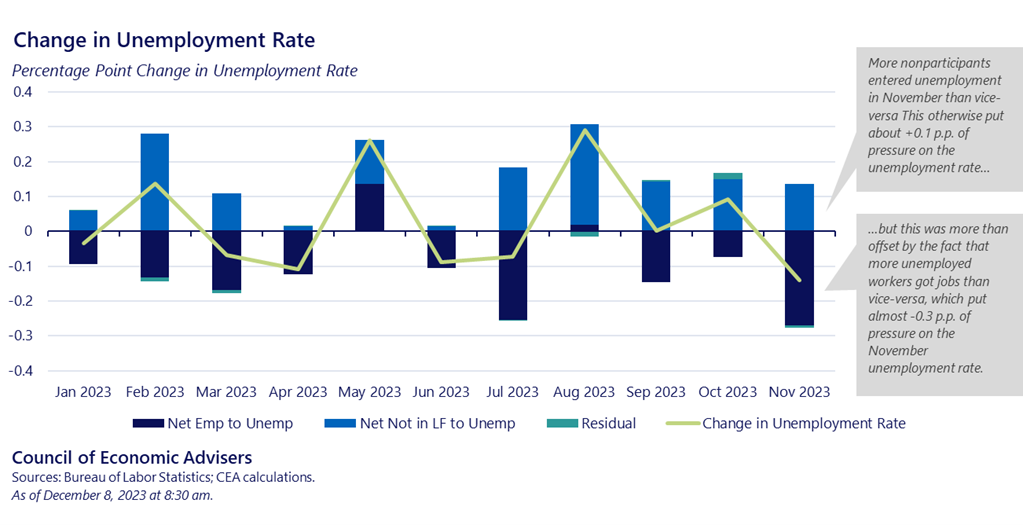Go with the flow: Getting beneath the surface of the jobs report
This morning’s jobs report showed payrolls were up 199,000 last month and the unemployment rate fell to 3.7 percent, making it 22 months in a row of unemployment below 4 percent, an over 50-year record. Though we are careful to not lean too hard into one month’s data, the monthly jobs report always provides important information about the main source of income for most working-age families.
That said, what we don’t tend to talk about is that these topline numbers just scratch the surface, much as the surface of the ocean tells you little about what’s going on in the depths.
To go beneath the surface, we need to look at labor market flows of people moving in and out of the job market as they transition from, for example, not-in-the-labor-force (n) to employment (e) or unemployment (u) as well as between these various states, such as from unemployment to employment (ue) or from employment to not-in-the-labor-force (en).
Why do these flows matter? Consider an increase in the unemployment rate. One might assume that an increase occurred because more people experienced layoffs or were terminated from their jobs. But unemployment could also rise because people came into the job market and didn’t find work right away. Or consider recent increases in the labor force. The labor force (e + u) could rise because more people were flowing into it or fewer than usual people were flowing out of it (i.e., a decrease in un and/or en).
Understanding the underlying equations (see appendix for details) helps us understand how these flows affect the current unemployment rate. The key point is that the change in the unemployment rate from one period to the next is (roughly) the net flow from e to u and the net flow from n to u.
Here’s how to think about this. Consider a room—probably not the happiest room in the house—where the unemployed all get together. Every month, people come into and leave that room. Some enter from door “e”, some enter from door “n”. Conversely, some leave the room through door “e” (i.e., they get jobs…yay!) while some leave room “u” through door “n” (perhaps a well-deserved retirement, or maybe someone who’s given up looking for work). As equation 2 in the appendix shows, the net of these flows (plus a small residual) equals the change in unemployment over that period.
With that deep-water training course behind us, put on your mask, fins, and scuba tank, as you’re ready to dive beneath the surface.
The figure below shows that change in the unemployment rate (the green line) over the last few months, with each bar showing the contribution from net nu and eu (and a third showing a residual). Last month, the unemployment rate fell 0.2 percentage point (p.p.) from 3.9 to 3.7 percent. This was attributable to a fairly substantial fall in the net eu flow arising from an increase in the number of workers who found jobs (ue) and decline in the number that lost (eu). These are both positive developments for the labor market: more people left the unemployment room for jobs and fewer people entered the room from job losses.
Monthly changes in flows are particularly noisy, underscoring our care to not over-interpret one or two months. Looking over the last few months, we have seen a notable shift up in the light blue bars, or the net flow from nu, from about +0.1 p.p. over January to June to about +0.2 p.p. from July through November. This suggests that the rising LFPR explains some of the increase in the unemployment rate from 3.5 percent in July to 3.7 percent last month, a positive aspect of post-pandemic normalization of the economy’s supply-side. At the same time, net eu flows have put similar downward pressure on the unemployment rate of about 0.1 p.p. per month over those two periods, reflecting both relatively steady eu flows—consistent with stable initial claims for unemployment insurance—as well as continued modest increases in ue flows.
While we will always start with the toplines, which are the quickest and most important way to quickly assess labor market conditions, CEA will continue to track these flows as we believe it is important to get below the surface and into the seaweed.

As the Administration stresses every quarter, economic data can be volatile and are subject to substantial revision. Therefore, it is important not to read too much into any single report, and it is informative to consider each report in the context of other data as they become available.
Appendix
The change in the number unemployed in any month t is given by

Inflows into unemployment are from employment, eut (e.g., job loss), and from out of the labor force, nut (e.g., new job searchers). Outflows from unemployment are to employment, eut (job finding) or to out of the labor force, unt (e.g., discouraged workers). There are other marginal flows that we will not focus on and will include in a residual.[1] In addition, we want to decompose the change in the unemployment rate, i.e. the number unemployed divided by the number in the labor force, and so we include a technical adjustment for the changing labor force in the residual as well.

[1] These marginal flows are the result of individuals entering the civilian non-institutional population because they turned 16, or because they left an institutional setting such as a prison. Deaths and other flows out of the population are incorporated into this residual as well via the population adjustment. As can be seen in the figure, the residual is typically very small.
